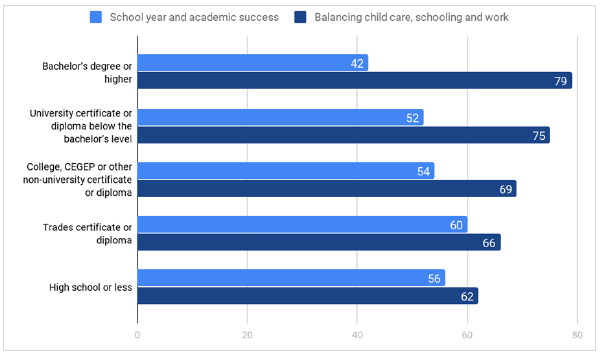
A Tectonic Shift in the Digital Divide: It’s now deeper than a technological gap
This issue of JSGS Policy Brief is part of a series dedicated to exploring and providing evidence-based analysis, policy ideas, recommendations and research conclusions on the various dimensions of the pandemic, as it relates here in Canada and internationally.
By Cheryl Camillo, Assistant Professor, Johnson Shoyama Graduate School of Public Policy (JSGS); Justin Longo, JSGS Associate ProfessorEmergency public health measures adopted in the spring of 2020 to slow the spread of coronavirus (COVID-19) forced the transfer from a physical to a virtual environment of most previously in-person activities and communications. This sudden and momentous shift has gone seamlessly for some, but frustratingly for others.
There have been several positive results. Students at all levels (from kindergarten to post-graduate) have learned how to navigate online learning environments; employees of all ages have become accustomed to working from home using Zoom and other digital information and communication tools; health systems have acted to enable providers to give virtual care over the phone or Internet; and jurisdictions where governments had invested in the delivery of public services by digital means have successfully weathered dramatic increases in inquiries and applications.1,2,3,4
Innovators have also demonstrated how a broad range of activities can continue at a physical distance. For example, private sector retailers took advantage of their pre-pandemic online presence to ramp up ordering and delivery, or quickly reconfigured in-person shopping to e-commerce; restaurants partnered with ordering and delivery apps to provide an alternative to home cooked meals; and entertainers delivered music through a variety of new vehicles. 5,6,7 Even social events moved online, from family gatherings to dating to beer pong tournaments.
On the other side, family members struggled to keep up with work and school when forced to share space, computer devices, and Internet bandwidth.8 The shift of activities to the home caused parents and children, and even teachers, to take desperate actions, such as driving around their communities after dark searching for wireless hotspots so that they could complete their online tasks. In addition, isolation, financial uncertainty, and illness resulting from the pandemic caused the self-reported mental health of an estimated one-half of Canadians to worsen.9
Because this transition to virtual activities has gone well for some, it is easy to overlook the so-called digital divide that separates Canadians. However, the longer that policies are in place to require or encourage individuals to work, study, shop, and access services at a physical distance from one another the deeper the divide will become, unless policymakers act to close it.
Proposed solutions will need to take into account new fault lines in the digital divide. Widespread physical distancing guidelines have compressed work, education, service, shopping, entertainment, and social activities into the same space—the home—the same time period—the business day—and fewer hands—generally only those of the household members. On a typical day in “pandemic lockdown,” one parent might be participating in a series of meetings via Zoom from the dining room table while searching the Internet for information about proper laptop ergonomics. The other parent might be attempting to apply for employment insurance or emergency response benefits from the kitchen while assisting one child with a math lesson, creating a new activity for a bored pre-Kindergarten child, and trying to phone a nurse for an update about a senior parent in a care home.
Generally, family/household members are performing such activities with more limited access to human resources staff, teachers, or retail clerks than they would have had when physically present at the office, school, or brick and mortar store. Due to this tectonic shift of daily activities to the home, policymakers should draw ideas and lessons for maximizing the ability to engage in online activities from public and private sector programs that support individuals fully engaging in their work.
Pre-pandemic Perspectives on the Digital Divide: Gaps in Access
The term “digital divide” was coined in the mid-1990s to signal disparities and inequalities arising from differential access to digital information and communications technologies.10 An oft-cited example in Canada has been geographic disparities in access to home broadband service. Broadband has been defined by the Canadian Radio-television and Telecommunications Commission (CRTC) as always-on Internet connectivity at a minimum speed of 50 megabits per second (Mbps) download and 10 Mbps upload. By this standard, homes in northern, rural, remote, and especially First Nation communities have persistently had significantly worse Internet connectivity than homes in urban communities. Another example of the divide is disparities in home computer ownership that have persisted over time—nearly all families in the highest income quintile have such devices whereas only 65-75% of families in the lowest quintile do.11
Since the 1990s, several causes of digital inequalities have been theorized. Jan Van Dijk’s recent review of the research found that inequalities in individuals’ motivation, material (financial and physical) means, skills (operational, informational, and strategic), and usage cause inequalities in access. Other research has identified poorly designed digital services and civic engagement platforms as supply-side causes.
A common approach to assessing the divide has been to measure and compare the costs and rates of ownership, coverage, and usage by persons and households across demographic and geographic groups. For example, the CRTC produces an annual Communications Monitoring Report summarizing the adoption of communication technologies and trends in expenditures by households across the provinces/territories, geographic locations (urban, rural, etc.), income quintiles, and age groups. Statistics Canada’s periodic Canadian Internet Use Survey measures the impact of technologies on individual Canadians with questions like “Do you use the Internet at home?” and “Have you done any telework?”
Reflecting these hitherto narrow approaches to conceptualizing and measuring the divide, policy initiatives to close it have typically aimed to expand material access for persons and households, and sometimes communities. The Government of Canada’s main digital divide initiative, in 2019 partners with private sector companies to “ improve access to the latest mobile wireless services where Canadians live and work, and along highways and major roads.” The strategy builds on earlier investments, such as the Connect to Innovate program, which provided funding to incentivize rural and remote communities and telecommunications companies to collaborate on building backbone and last-mile infrastructure to enable anchor institutions like libraries to connect to high-speed Internet.
Unsurprisingly, much of the emphasis in the months since COVID-19 has been on closing the digital divide by providing more digital tools. While distributing free tablets and subsidizing Internet connections are certainly constructive steps, such policies only bridge, rather than close, the new fault lines opened as a result of the tectonic shift of activities to the home. In assuming that more, better, and faster technologies can, in and of themselves, bridge the digital divide, the current approach risks deepening and widening the divide rather than working to permanently close it.12
New Fault Lines Created by Pandemic Pressures
The COVID-19 pandemic is revealing that individuals and households can have the capacity and technology to connect to well-designed public service portals and learning platforms but cannot succeed at performing most of these activities in the home without social and institutional supports, which can be more challenging to acquire than technical devices. Yes, digital technology has allowed many to seamlessly transition from going into the office to working from home, thereby cutting their commute down to the time it takes to shuffle from the bedroom to the kitchen for a cup of coffee, and then into the home office. But the shift of work and education from institutions to the home has not been a good experience for the student required to keep her video and microphone on during a Zoom class, effectively allowing the instructor and her peers to invade the privacy of her home. Nor has the transition been seamless for the single parent required to work a full day at home while tutoring his three children with whom he shares a single laptop computer and one smartphone with a data-limited cellular connection to the Internet. An April 2020 essay “The Parents Are Not Alright” gave voice to the virtualization struggle of parents with school-aged children: “We both felt guilty for the work we were not doing — and aching for the way our son was struggling and needed us to be present and calm. But that’s exactly what our current schedule prohibits, as we run back and forth between work calls, requests, and parenting… We feel like we’re failing at both.”13
The implications of unequal capacities to work, study, socialize, and entertain at home loom heavily over the school year. The author of “The Parents Are Not Alright” acknowledged her relatively privileged position as co-parent of one child in a family in which both parents are educated professionals committed to sharing caretaking responsibilities. Nonetheless, more highly educated parents, while expressing heightened concerns over their ability to continue balancing the competing demands of child care, home schooling, and work, appear better positioned to help their children perform learn-from-home activities. A Statistics Canada online non-probability-based survey of Canadian parents conducted in June 2020 reported (see Figure 1 below) that the frequency with which children participated in academic activities when online learning resources were introduced in the wake of school closures increased with the level of the parent’s education.14 “Eighty percent of participants with a bachelor’s degree or higher reported that their children engaged in structured academic activities at home three times per week or more, compared with 72% of participants with a college certificate or diploma, 69% of those with a trades certificate or diploma and 67% of participants with a high school diploma or less.” One can imagine the challenges faced by parents of children with a disability, who reported being extremely concerned about the school year compared to other parents, or those faced by single parents of multiple children with neither the material assets nor skills needed to work and teach from home, or those faced by women living in more socially “traditional” households who have to perform the “second shift” of housework and homework by themselves.15
Figure 1: Proportion concerned about children’s school year or academic success and balancing child care, schooling, and work, by level of parental education

A Proposed New Approach for Closing the Divide
Canadian public health officials are anticipating that the number of COVID-19 cases will increase in the fall and winter due to increased opportunities for transmission resulting from the reopening of school campuses, as well as the onset of colder, drier weather conditions that have been shown to promote the spread of related viruses.16 The World Health Organization (WHO) has warned that there is no “silver bullet” on the horizon to end coronavirus outbreaks, so public health measures like physical distancing might need to be in place for the foreseeable future.17
As the controversy surrounding the reopening of K-12 schools in Saskatchewan and other provinces demonstrates, Canadian governments need to engage in intensive, thoughtful policymaking regarding how all Canadians can fully engage in digital employment, educational, and civic activities.18 If policymakers do not make such focused efforts, but instead choose to let social and economic forces play out, Canadian economies will not fully recover because many individuals who were not participating in the economy prior to the pandemic will be unlikely to start doing so and others who were fully participating will drop out due to the pressures that created new fault lines in the digital divide. Parents of school-aged children with financial and technological means might send their kids to private schools that they perceive as having a safer reopening strategy or a more structured approach to delivering online learning, or might organize with neighbourhood friends to set up “homeschooling pods” or micro-schools in which they hire a professional teacher to instruct their children or take turns teaching the children themselves. Parents without such means will send their kids to public schools with the hope they will not contract COVID-19 or will sacrifice their employment or social prospects to homeschool their kids, which will widen existing inequalities.19
In formulating policies to close the divide, policymakers should keep four things in mind:
- Participation in the online world should be treated as a core principle of citizenship;
- The digital divide is more than technological—it has spatial, temporal, and social dimensions;
- Technical solutionism can only temporarily bridge the digital divide, not permanently close it; and
- Policy solutions should reflect lessons from initiatives that have sought to enable disadvantaged individuals to work or pursue higher education while also caring for their families.
The pandemic crisis reinforces how access to the full capacity of the Internet can uniquely enable individuals to participate in society by working, running a business, engaging in civic activities, educating themselves, and socializing with families and friends even when confined to their homes for multiple months to protect their health. Given the Internet’s unique power, being able to effectively participate in the online world should be considered a core principle of citizenship. For those who are prevented from fully participating in mainstream society in normal times due to, for example, inadequate child care or transportation options, digital mediums can help overcome those barriers.
Yet, the physical distancing guidelines necessitated by the pandemic that suddenly limited us to engaging via the Internet, unintentionally undermined one of the basic premises of the Canadian social contract—that there are spatial and temporal boundaries between our public (work, civic, and educational) and private lives. By forcing work, education, and public and private services to shift online (when possible) with insufficient notice to reconsider official business hours, revise employment contracts, or make plans to dispatch (in a safe manner) support services that would normally be available at the institution, the measures adopted to protect public health essentially compelled individuals to work and learn from their own homes while simultaneously performing the support services, such as the installation of computer devices, for themselves. While in the pre-pandemic period increasing numbers of Canadians had been taking advantage of rapidly developing technologies to telework, take online classes, and access services remotely, they were largely doing so on a voluntary basis after having made the necessary arrangements to be successful.
A solely technological solution to closing the digital divide has been and will continue to be illusory, as we have been warned.20 Webcasts for using Zoom more effectively in and of themselves will not help Canadians balance work, family, social, and civic life, and play.
Instead, more promising approaches to closing the divide will not only provide material and technical access to computer devices and connections but supports to enable individuals to use them while balancing family, civic, and social life. These approaches would build on lessons from a variety of initiatives to promote employment/educational success and health and well-being, ranging from employee assistance programs, to work incentive programs for disabled persons, to welfare-to-work programs in the United States, which had more success when offering participants a slate of services.21
Conclusion
As Canada moves into its first fall and winter since the coronavirus outbreak, policymakers need to confront the fact that the pandemic has fundamentally restructured our lives by relocating many previously external employment, educational, and social activities to the home. Closing the digital divide can help Canada thrive throughout the pandemic and beyond, but doing so will require big picture thinking with contributions from all sectors of our society from farm associations to indigenous communities to social services organizations to labour unions. Now is the time for our policymakers to bring us together to close the gap.
ISSN 2369-0224 (Print) ISSN 2369-0232 (Online)
References
1 Bates, Tony. "Online enrolments after COVID-19: some predictions for Canada." May 11, 2020. https://www.universityaffairs.ca/opinion/in-my-opinion/online-enrolments-after-covid-19-some-predictions-for-canada/
2 Angus Reid Institute. So long, office space? Two-thirds of Canadians who work from home expect it to continue after pandemic [Internet]. Angus Reid Institute; June 11, 2020. http://angusreid.org/coronavirus-work-from-home/
3 Canada Health Infoway. Rapid Response to COVID-19. 2020. [Internet]. https://www.infoway-inforoute.ca/en/solutions/rapid-response-to-covid-19
4 United Nations Department of Economic and Social Affairs. UN/DESA Policy Brief #61: COVID-19: Embracing digital government during the pandemic and beyond [Internet]. April 14, 2020. https://www.un.org/development/desa/dpad/publication/un-desa-policy-brief-61-covid-19-embracing-digital-government-during-the-pandemic-and-beyond/
5 Solis, Brian. "COVID-19 thrusts e-commerce into the spotlight." CIO. April 21, 2020. https://www.cio.com/article/3538777/covid-19-thrusts-e-commerce-into-the-spotlight.html
6 Rawes, Erika, Dove, Jackie, and Alina Bradford. "The best food-delivery apps for 2020." Digital Trends. July 24, 2020. https://www.digitaltrends.com/home/best-food-delivery-apps/
7 Regina Folk Festival. Drive-in concerts. 2020. https://reginafolkfestival.com/drive-in-concerts
8 Davenport, Cole. "Opposition calling on province for supplemental learning supports as schools remain closed." CTV News. April 21, 2020. https://regina.ctvnews.ca/opposition-calling-on-province-for-supplemental-learning-supports-as-schools-remain-closed-1.4906257
9 Angus Reid Institute. Worry, Gratitude & Boredom: As COVID-19 affects mental, financial health, who fares better; who is worse? [Internet]. Angus Reid Institute; April 27, 2020. http://angusreid.org/covid19-mental-health/
10 van Dijk, Jan A.G.M. 2006. Digital divide research, achievements, and shortcomings. Poetics (34): 221-235.
11 Canadian Radio-television and Communications and Telecommunications Commission. 2019. Communications Monitoring Report 2019. https://crtc.gc.ca/pubs/cmr2019-en.pdf
12 DeClerq, Katherine. "Ontario distributing free iPads to kids who cannot access province's online learning tools." CTV News. April 17, 2020. https://toronto.ctvnews.ca/ontario-distributing-free-ipads-to-kids-who-cannot-access-province-s-online-learning-tools-1.4900317
13 Chloe I. Cooney. "The parents are not all right." GEN. April 5, 2020. https://gen.medium.com/parents-are-not-ok-66ab2a3e42d9
14 Greenlee, Edith and Alana Reid. Parents Supporting Learning At Home During The COVID-19 Pandemic [Internet]. Statistics Canada Catalogue no. 45280001. July 16, 2020. https://www150.statcan.gc.ca
15 Stroh, Perlita. "Pandemic threatens to wipe out decades of progress for working mothers." CBC News. August 17, 2020. https://www.cbc.ca/news/business/women-employment-covid-economy-1.5685463
16 Harris, Kathleen. "Health officials warn of potential 'fall peak' in COVID-19 cases in Canada." CBC News. August 14, 2020. https://www.cbc.ca/news/politics/covid19-pandemic-modelling-tam-fall-peak-1.5686250
17 Agence France-Presse. "WHO: No ‘silver bullet’ vs virus." Manila Times. August 5, 2020. https://www.manilatimes.net/2020/08/05/news/national/who-no-silver-bullet-vs-virus/751009/
18 Holinaty, Carla. "Sask. teachers and kids deserve better than this inadequate back to school plan." CBC SK Opinion. August 6, 2020. https://www.cbc.ca/news/canada/saskatchewan/holinaty-op-ed-school-reopening-1.5677137
19 Bastian, Rebekah. "how educational inequality in America could be impacted by the homeschooling pod frenzy." Forbes. July 19, 2020. https://www.forbes.com/sites/rebekahbastian/2020/07/19/how-educational-inequality-in-america-could-be-impacted-by-the-homeschooling-pod-frenzy/#7dbc767972cb
20 Ullman, Ellen. "Big data is watching you." The New York Times Book Review. May 17, 2013. https://www.nytimes.com/2013/05/19/books/review/to-save-everything-click-here-by-evgeny-morozov.html
21 Manpower Demonstration Research Corporation. National Evaluation of Welfare-to-Work Strategies: Evaluating Alternative Welfare-to-Work Approaches: Two-Year Impacts for Eleven Programs: Executive Summary [Internet]. U.S. Department of Health and Human Services; June 1, 2000. https://aspe.hhs.gov/basic-report/national-evaluation-welfare-work-strategies-evaluating-alternative-welfare-work-approaches-two-year-impacts-eleven-programs-executive-summary#I
Cheryl Camillo

Cheryl Camillo has worked in many capacities to reduce economic and social disparities in the United States and Canada, including as senior federal policymaker, state program executive, community organizer, and applied researcher. She has a bachelor’s degree in political science from Yale University, a master of public administration degree from Syracuse University and a PhD in public policy from the University of Maryland. A former Fulbright Fellow, Camillo teaches social policy and health policy at JSGS.
Justin Longo


